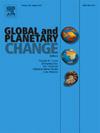The future extent of the Anthropocene epoch: A synthesis
IF 4
1区 地球科学
Q1 GEOGRAPHY, PHYSICAL
引用次数: 0
Abstract
We synthesize research from complementary scientific fields to address the likely future extent and duration of the proposed Anthropocene epoch. Intensification of human-forced climate change began from about 1970 onwards with steepening increases in greenhouse gases, ocean acidification, global temperature and sea level, along with ice loss. The resulting distinction between relatively stable Holocene climatic conditions and those of the proposed Anthropocene epoch is substantial, with many aspects irreversible. The still-rising trajectory of greenhouse gas emissions is leading to yet greater and more permanent divergence of the Anthropocene from the Holocene Earth System. We focus here on the effects of the ensuing climate transformation and its impact on the likely duration of this novel state of the Earth System.
Given the magnitude and rapid rise of atmospheric carbon dioxide (CO2), its long lifetime in the atmosphere, and the present disequilibrium in Earth's energy budget (expressed as the Earth's Energy Imbalance, or EEI), both temperatures and sea level must continue to rise – even with carbon emissions lowered to net zero (where anthropogenic CO2 emissions = anthropogenic CO2 removals) – until the energy budget balance is eventually restored. Even if net zero were achieved immediately, elevated global temperatures would persist for at least several tens of millennia, with expected levels of warmth by the end of this century not seen since the early Late Pliocene. Interglacial conditions are likely to persist for at least 50,000 years under already-accumulated CO2 emissions and Earth's low eccentricity orbit. Continued increases in greenhouse gas emissions are likely to extend that persistence to around 500,000 years, suppressing the pronounced expression of Milankovitch cyclicity typical of the later Pleistocene Epoch. This major perturbation alone is sufficient to justify the Anthropocene as terminating the Holocene Epoch. The wider and mostly irreversible effects of climate change, not least in amplifying reconfiguration of the biosphere, emphasize the scale of this departure from Holocene conditions, justifying the establishment of a new epoch.
Given such perspectives, the Anthropocene epoch represents what will become a lasting and substantial change in the Earth System. It is the Holocene Epoch at only 11,700 years duration that will appear as the ‘blip’ in the Geological Time Scale, a brief interval when complex, settled human societies co-existed with, but did not overwhelm, a stable Earth System.
人类纪元的未来范围:综述
我们综合了互补科学领域的研究,以探讨拟议的人类纪元未来可能的范围和持续时间。大约从1970年起,随着温室气体、海洋酸化、全球气温和海平面的急剧上升以及冰川的消失,人类迫使气候变化开始加剧。因此,相对稳定的全新世气候条件与拟议中的人类世气候条件之间的差异很大,许多方面是不可逆转的。温室气体排放的轨迹仍在上升,这将导致人类世与全新世地球系统出现更大、更持久的差异。鉴于大气中二氧化碳(CO2)的规模和快速增长、其在大气中的漫长寿命以及目前地球能量预算的失衡(以地球能量失衡(EEI)表示),在能量预算平衡最终恢复之前,温度和海平面都必须继续上升--即使碳排放量降低到净零(即人为二氧化碳排放量 = 人为二氧化碳清除量)。即使立即实现净零排放,全球气温升高也将持续至少几十上千年,预计到本世纪末将达到上新世晚期以来从未有过的温暖程度。在已经累积的二氧化碳排放量和地球低偏心率轨道的作用下,间冰期可能会持续至少 5 万年。温室气体排放量的持续增加可能会将这种持续时间延长到 50 万年左右,从而抑制更新世晚期典型的米兰科维奇周期性的明显表现。仅这一重大扰动就足以证明人类世终止了全新世。气候变化的影响范围更广,而且大多不可逆转,尤其是扩大了生物圈的重新配置,凸显了这一偏离全新世条件的规模,从而有理由建立一个新的纪元。全新世纪元只有 11,700 年的历史,在地质时间尺度中将被视为 "昙花一现",这是一个复杂的、定居的人类社会与稳定的地球系统共存的短暂时期,但并没有压倒稳定的地球系统。
本文章由计算机程序翻译,如有差异,请以英文原文为准。
求助全文
约1分钟内获得全文
求助全文
来源期刊

Global and Planetary Change
地学天文-地球科学综合
CiteScore
7.40
自引率
10.30%
发文量
226
审稿时长
63 days
期刊介绍:
The objective of the journal Global and Planetary Change is to provide a multi-disciplinary overview of the processes taking place in the Earth System and involved in planetary change over time. The journal focuses on records of the past and current state of the earth system, and future scenarios , and their link to global environmental change. Regional or process-oriented studies are welcome if they discuss global implications. Topics include, but are not limited to, changes in the dynamics and composition of the atmosphere, oceans and cryosphere, as well as climate change, sea level variation, observations/modelling of Earth processes from deep to (near-)surface and their coupling, global ecology, biogeography and the resilience/thresholds in ecosystems.
Key criteria for the consideration of manuscripts are (a) the relevance for the global scientific community and/or (b) the wider implications for global scale problems, preferably combined with (c) having a significance beyond a single discipline. A clear focus on key processes associated with planetary scale change is strongly encouraged.
Manuscripts can be submitted as either research contributions or as a review article. Every effort should be made towards the presentation of research outcomes in an understandable way for a broad readership.
 求助内容:
求助内容: 应助结果提醒方式:
应助结果提醒方式:


